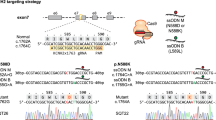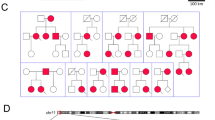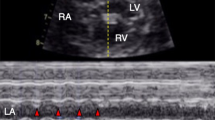Abstract
Previous studies have identified mutations in five ion channel genes as a cause of long QT syndrome, a heterogeneous disorder characterized by prolongation of the QT interval, multiform ventricular tachycardia (torsades de pointes), seizures, syncope, and sudden death. However, in these studies, the average age of initial symptoms is in the third decade of life or later, and few reports have described the genetic causes of long QT syndrome presenting in the prenatal or neonatal period. We used a candidate gene approach to identify the genetic cause of long QT syndrome in an infant whose initial manifestations were detected in utero. Direct bidirectional sequencing of long QT syndrome genes identified a previously unreported HERG missense mutation (R752Q). Three asymptomatic family members were heterozygous for R752Q, and the proband, who manifested ventricular tachycardia in utero, was homozygous. R752Q was not found in 100 normal unrelated chromosomes. Paternal DNA was unavailable for testing. Transient transfection of HERG generated robust IKr, but no current was observed for the mutant HERG. The HERG mutant, R752Q, is associated with a mild phenotype, inasmuch as family members with a heterozygous mutation appear unaffected. The homozygous mutation results in absence of functional IKr, causing a profound loss of HERG channel function, creating the equivalent of a “HERG knockout” and leading to a severe phenotype.
Similar content being viewed by others
Log in or create a free account to read this content
Gain free access to this article, as well as selected content from this journal and more on nature.com
or
Abbreviations
- QTc:
-
corrected QT interval
- HERG, KVLQT1, KCNE1, and KCNE2:
-
cardiac potassium channel component genes
- IKr:
-
inward potassium rectifier current
- LQTS:
-
long QT syndrome
References
Splawski I, Shen J, Timothy KW, Lehmann MH, Prori S, Robinson JL, Moss AJ, Schwartz PJ, Towbin JA, Vincent GM, Keating MT 2000 Spectrum of mutations in long-QT syndrome genes. KVLQT1, HERG, SCN5A, KCNE1, and KCNE2. Circulation 102: 1178–1185
Benson DW, Silberbach GM, Kavanaugh-McHugh A, Cottrill C, Zhang Y, Riggs S, Smalls O, Johnson MC, Watson MS, Seidman JG, Seidman CE, Plowden J, Kugler JD 1999 Mutations in the cardiac transcription factor NKX2.5 affect diverse cardiac developmental pathways. J Clin Invest 104: 1567–1573
Basson CT, Bachinsky DR, Lin RC, Levi T, Elkins JA, Soults J, Grayzel D, Kroumpouzou E, Traill TA, Leblanc-Straceski J, Renault B, Kucherlapati R, Seidman JG, Seidman CE 1997 Mutations in human TBX5 cause limb and cardiac malformation in Holt-Oram syndrome. Nat Genet 15: 30–35
Wolff DJ, Brown CJ, Schwartz S, Duncan AM, Surti U, Willard HF 1994 Small marker chromosomes lack the X inactivation center: implications for karyotype/phenotype correlations. Am J Hum Genet 55: 87–95
Benson DW, Sharkey A, Fatkin D, Lang P, Basson CT, McDonough B, Strauss AW, Seidman JG, Seidman CE 1998 Reduced penetrance, variable expressivity and genetic heterogeneity of familial atrial septal defect. Circulation 97: 2043–2048
Yang T, Snyders DJ, Roden DM 2001 Drug block of IKr: model systems and relevance to human arrhythmias. J Cardiovasc Pharmacol 38: 737–744
Benson DW, MacRae CA, Vesely MR, Walsh EP, Seidman JG, Seidman CE, Satler CA 1996 Missense mutation in the pore region of HERG causes familial long QT syndrome. Circulation 93: 1791–1795
Itoh T, Tanaka T, Nagai R, Kikuchi K, Ogawa S, Okada S, Yamagata S, Yano K, Yazaki Y, Nakamura Y 1998 Genomic organization and mutational analysis of KVLQT1, a gene responsible for familial long QT syndrome. Hum Genet 103: 290–294
Hofbeck M, Ulmer H, Beinder E, Sieber E, Singer H 1997 Prenatal findings in patients with prolonged QT interval in the neonatal period. Heart 77: 198–204
Yamada M, Nakazawa M, Momma K 1998 Fetal ventricular tachycardia in long QT syndrome. Cardiol Young 8: 119–122
Ohkuchi A, Shiraishi H, Minakami H, Eguchi Y, Izumi A, Sato I 1999 Fetus with long QT syndrome manifested by tachyarrhythmia: a case report. Prenat Diagn 19: 990–992
Priori SG, Napolitano C, Schwartz PJ 1999 Low penetrance in the long-QT syndrome. Circulation 99: 529–533
Piippo K, Laitinen P, Swan H, Toivonen L, Viitasalo M, Pasternack M, Paavonen K, Chapman H, Wann KT, Hirvela E, Sajantila A, Kontula K 2000 Homozygosity for a HERG potassium channel mutation causes a severe form of long QT syndrome: identification of an apparent founder mutation in the Finns. J Am Coll Cardiol 35: 1919–1925
Hoorntje T, Alders M, van Tintelen P, van der Lip K, Sreeram N, van der Wal A, Mannens M, Wilde A 1999 Homozygous premature truncation of the HERG protein: the human HERG knockout. Circulation 100: 1264–1267
Ficker E, Thomas D, Viswanathan PC, Dennis AT, Priori SG, Napolitano C, Memmi M, Wible BA, Kaufman ES, Iyengar S, Schwartz PJ, Rudy Y, Brown AM 2000 Novel characteristics of a misprocessed mutant HERG channel linked to hereditary long QT syndrome. Am J Physiol 279: H1748–H1756
Splawski I, Timothy KW, Tateyama M, Clancy CE, Malhotra A, Beggs AH, Cappuccio FP, Sagnella GA, Kass RS, Keating MT 2002 Variant of SCN5A sodium channel implicated in risk of cardiac arrhythmia. Science 297: 1333–1336
Yang P, Kanki H, Drolet B, Yang T, Wei J, Viswanathan PC, Hohnloser SH, Shimizu W, Schwartz PJ, Stanton M, Murray KT, Norris K, George AL, Roden DM 2002 Allelic variants in long-QT disease genes in patients with drug-associated torsades de pointes. Circulation 105: 1943–1948
Author information
Authors and Affiliations
Additional information
Supported, in part, by Grants HL49989 (D.M.R.) and HL04300 (D.W.B) from the National Institutes of Health, Bethesda, MD, U.S.A.
Rights and permissions
About this article
Cite this article
Johnson, W., Yang, P., Yang, T. et al. Clinical, Genetic, and Biophysical Characterization of a Homozygous HERG Mutation Causing Severe Neonatal Long QT Syndrome. Pediatr Res 53, 744–748 (2003). https://doi.org/10.1203/01.PDR.0000059750.17002.B6
Received:
Accepted:
Issue date:
DOI: https://doi.org/10.1203/01.PDR.0000059750.17002.B6
This article is cited by
-
hERG-deficient human embryonic stem cell-derived cardiomyocytes for modelling QT prolongation
Stem Cell Research & Therapy (2021)
-
Congenital long QT syndrome with compound mutations in the KCNH2 gene
Heart and Vessels (2014)
-
Inherited long QT syndrome
Herzschrittmachertherapie + Elektrophysiologie (2012)
-
HERG1 channelopathies
Pflügers Archiv - European Journal of Physiology (2010)
-
Clinical and Genetic Analysis of Long QT Syndrome in Children from Six Families in Saudi Arabia: Are They Different?
Pediatric Cardiology (2009)



